- Home
- Oliver Sacks
The River of Consciousness Page 13
The River of Consciousness Read online
Page 13
In Purves’s view, it is precisely this decomposition of what we see into a succession of moments that enables the brain to detect and compute motion, for all it has to do is to note the differing positions of objects between successive “frames” and from these calculate the direction and speed of motion.
But this is not enough. We do not merely calculate movement as a robot might; we perceive it. We perceive motion, just as we perceive color or depth, as a unique qualitative experience that is vital to our visual awareness and consciousness. Something beyond our understanding occurs in the genesis of qualia, the transformation of an objective cerebral computation to a subjective experience. Philosophers argue endlessly over how these transformations occur and whether we will ever be capable of understanding them.
James imagined a zoetrope as a metaphor for the conscious brain, and Bergson compared it to cinematography, but these were, of necessity, no more than tantalizing analogies and images. It has only been in the last twenty or thirty years that neuroscience could even start to address such issues as the neural basis of consciousness.
From having been an almost untouchable subject before the 1970s, the neuroscientific study of consciousness has now become a central concern, one that engages scientists all over the world. Every level of consciousness is now being explored, from the most elemental perceptual mechanisms (mechanisms common to many animals besides ourselves) to the higher reaches of memory, imagery, and self-reflective consciousness.
Is it possible to define the almost inconceivably complex processes that form the neural correlates of thought and consciousness? We must imagine, if we can, that in our brains with their hundred billion neurons, each with a thousand or more synaptic connections, there may emerge or be selected, within fractions of a second, a million-odd neuronal groups or coalitions, each with a thousand or ten thousand neurons apiece. (Edelman speaks here of the “hyperastronomical” magnitudes involved.) All of these coalitions, like the “millions of flashing shuttles” in Sherrington’s enchanted loom, are in communication with each other, weaving, many times a second, their continuously changing but always meaningful patterns.
We cannot begin to catch the density, the multifariousness of it all, the superimposed and mutually influencing layers of the stream of consciousness as it flows, constantly changing, through the mind. Even the highest powers of art—whether in film, or theater, or literary narrative—can only convey the faintest intimation of what human consciousness is really like.
It is now possible to monitor simultaneously the activities of a hundred or more individual neurons in the brain and to do so in unanesthetized animals given simple perceptual and mental tasks. We can examine the activity and interactions of large areas of the brain by means of imaging techniques like functional MRIs and PET scans, and such noninvasive techniques can be used with human subjects to see which areas of the brain are activated in complex mental activities.
In addition to physiological studies, there is the relatively new realm of computerized neural modeling, using populations or networks of virtual neurons and seeing how these organize themselves in response to various stimuli and constraints.
All of these approaches, along with concepts not available to earlier generations, now combine to make the quest for the neural correlates of consciousness the most fundamental and exciting adventure in neuroscience today. A crucial innovation has been population thinking, thinking in terms that take account of the brain’s huge population of neurons and the power of experience to differentially alter the strengths of connections between them, and to promote the formation of functional groups or constellations of neurons throughout the brain—groups whose interactions serve to categorize experience.
Instead of seeing the brain as rigid, fixed in mode, programmed like a computer, there is now a much more biological and powerful notion of “experiential selection,” of experience literally shaping the connectivity and function of the brain (within genetic, anatomical, and physiological limits).
Such a selection of neuronal groups (groups consisting of perhaps a thousand or so individual neurons) and its effect on shaping the brain over the lifetime of an individual, is seen as analogous to the role of natural selection in the evolution of species; hence Gerald M. Edelman, who was a pioneer in such thinking in the 1970s, speaks of “neural Darwinism.” Jean-Pierre Changeux, more concerned with the connections of individual neurons, speaks of “the Darwinism of synapses.”
William James himself always insisted that consciousness was not a “thing” but a “process.” The neural basis of these processes, for Edelman, is one of dynamic interaction between neuronal groups in different areas of the cortex, as well as between the cortex and the thalamus and other parts of the brain. Edelman sees consciousness as arising from the enormous number of reciprocal interactions between memory systems in the anterior parts of the brain and systems concerned with perceptual categorization in the posterior parts of the brain.*4
Francis Crick and his colleague Christof Koch have also been pioneers in the study of the neural basis of consciousness. From their first collaborative work in the 1980s, they have focused more narrowly on elementary visual perception and processes, feeling that the visual brain was the most amenable to investigation and could serve as a model for investigating and understanding higher and higher forms of consciousness.*5
In a synoptic 2003 paper called “A Framework for Consciousness,” Crick and Koch speculated on the neural correlates of motion perception, how visual continuity is perceived or constructed, and, by extension, the seeming continuity of consciousness itself. They proposed that “conscious awareness [for vision] is a series of static snapshots, with motion ‘painted’ on them…[and] that perception occurs in discrete epochs.”
I was startled when I first came across this passage, because their formulation seemed to rest upon the same notion of consciousness that James and Bergson had intimated a century before, and the same notion that had been in my mind since I first heard accounts of cinematic vision from my migraine patients in the 1960s. Here, however, was something more, a possible substrate for consciousness based in neuronal activity.
The “snapshots” that Crick and Koch postulate are not uniform, like cinematic ones. The duration of successive snapshots, they feel, is not likely to be constant; moreover, the time of a snapshot for shape, say, may not coincide with one for color. While this “snapshotting” mechanism for visual sensory inputs is probably a fairly simple and automatic one, a relatively low-order neural mechanism, each percept must include a great number of visual attributes, all of which are bound together on some preconscious level.*6
How, then, are the various snapshots “assembled” to achieve apparent continuity, and how do they reach the level of consciousness?
While the perception of a particular motion (for example) may be represented by neurons firing at a particular rate in the motion centers of the visual cortex, this is only the beginning of an elaborate process. To reach consciousness, this neuronal firing, or some higher representation of it, must cross a certain threshold of intensity and be maintained above it; consciousness, for Crick and Koch, is a threshold phenomenon. To do that, this group of neurons must engage other parts of the brain (usually in the frontal lobes) and ally itself with millions of other neurons to form a “coalition.” Such coalitions, they conceive, can form and dissolve in a fraction of a second and involve reciprocal connections between the visual cortex and many other areas of the brain. These neural coalitions in different parts of the brain talk to one another in a continuous back-and-forth interaction. A single conscious visual percept may thus entail the parallel and mutually influencing activities of billions of nerve cells.
Finally, the activity of a coalition, or coalition of coalitions, if it is to reach consciousness, must not only cross a threshold of intensity but also be held there for a certain time—roughly a hundred milliseconds. This is the duration of a “perceptual moment.”*7
To expl
ain the apparent continuity of visual consciousness, Crick and Koch suggest that the activity of the coalition shows “hysteresis,” that is, a persistence outlasting the stimulus. This notion is very similar, in a way, to the “persistence of vision” theories advanced in the nineteenth century.*8 In his Treatise on Physiological Optics of 1860, Hermann von Helmholtz wrote, “All that is necessary is that the repetition of the impression shall be fast enough for the after-effect of one impression not to have died down perceptibly before the next one comes.” Helmholtz and his contemporaries supposed that this aftereffect occurred in the retina, but for Crick and Koch it occurs in the coalitions of neurons in the cortex. The sense of continuity, in other words, results from the continuous overlapping of successive perceptual moments. It may be that the forms of cinematographic vision I have described—with either sharply separated stills or blurred and overlapping ones—represent abnormalities of excitability in the coalitions, with either too much or too little hysteresis.*9
Vision, in ordinary circumstances, is seamless and gives no indication of the underlying processes on which it depends. It has to be decomposed, experimentally or in neurological disorders, to show the elements that compose it. The flickering, perseverative, time-blurred images experienced in certain intoxications or severe migraines lend credence to the idea that consciousness is composed of discrete moments.
Whatever the mechanism, the fusing of discrete visual frames or snapshots is a prerequisite for continuity, for a flowing, mobile consciousness. Such a dynamic consciousness probably first arose in reptiles a quarter of a billion years ago. It seems probable that no such stream of consciousness exists in amphibians. A frog, for example, shows no active attention and no visual following of events. The frog does not have a visual world or visual consciousness as we know it, only a purely automatic ability to recognize an insect-like object if one enters its visual field and to dart out its tongue in response. It does not scan its surroundings or look for prey.
If a dynamic, flowing consciousness allows, at the lowest level, a continuous active scanning or looking, at a higher level it allows the interaction of perception and memory, of present and past. And such a “primary” consciousness, as Edelman calls it, is highly efficacious, highly adaptive, in the struggle for life.
In his book Wider Than the Sky: The Phenomenal Gift of Consciousness, Edelman writes,
Imagine an animal with primary consciousness in the jungle. It hears a low growling noise, and at the same time the wind shifts and the light begins to wane. It quickly runs away, to a safer location. A physicist might not be able to detect any necessary causal relation among these events. But to an animal with primary consciousness, just such a set of simultaneous events might have accompanied a previous experience, which included the appearance of a tiger. Consciousness allowed integration of the present scene with the animal’s past history of conscious experience, and that integration has survival value whether a tiger is present or not.
From such a relatively simple primary consciousness, we leap to human consciousness, with the advent of language and self-consciousness and an explicit sense of the past and the future. And it is this which gives a thematic and personal continuity to the consciousness of every individual. As I write, I am sitting at a café on Seventh Avenue, watching the world go by. My attention and focus dart to and fro: a girl in a red dress goes by, a man walking a funny dog, the sun (at last!) emerging from the clouds. But there are also other sensations that seem to come by themselves: the noise of a car backfiring, the smell of cigarette smoke as an upwind neighbor lights up. These are all events which catch my attention for a moment as they happen. Why, out of a thousand possible perceptions, are these the ones I seize upon? Reflections, memories, associations, lie behind them. For consciousness is always active and selective—charged with feelings and meanings uniquely our own, informing our choices and interfusing our perceptions. So it is not just Seventh Avenue that I see but my Seventh Avenue, marked by my own selfhood and identity.
Christopher Isherwood starts “A Berlin Diary” with an extended photographic metaphor: “I am a camera with its shutter open, quite passive, recording, not thinking. Recording the man shaving at the window opposite and the woman in the kimono washing her hair. Some day, all this will have to be developed, carefully printed, fixed.” But we deceive ourselves if we imagine that we can ever be passive, impartial observers. Every perception, every scene, is shaped by us, whether we intend it or know it, or not. We are the directors of the film we are making—but we are its subjects too: every frame, every moment, is us, is ours.
But how then do our frames, our momentary moments, hold together? How, if there is only transience, do we achieve continuity? Our passing thoughts, as William James says (in an image that smacks of cowboy life in the 1880s), do not wander round like wild cattle. Each one is owned and bears the brand of this ownership, and each thought, in James’s words, is born an owner of the thoughts that went before, and “dies owned, transmitting whatever it realized as its Self to its own later proprietor.”
So it is not just perceptual moments, simple physiological moments—though these underlie everything else—but moments of an essentially personal kind that seem to constitute our very being. Finally, then, we come around to Proust’s image, itself slightly reminiscent of photography, that we consist entirely of “a collection of moments,” even though these flow into one another like Borges’s river.
* * *
*1 Étienne-Jules Marey, in France, like Eadweard Muybridge in the United States, pioneered the development of quick-fire, instantaneous serial photographs. While these could be arrayed around a zoetrope drum to provide a brief “movie,” they could also be used to decompose movement, to investigate the temporal organization and biodynamics of animal and human motion. This was Marey’s special interest as a physiologist, and for this purpose he preferred to superimpose his images—a dozen or twenty images, a second’s worth—on a single plate. Such composite photographs, in effect, captured a span of time; this is why he called them “chronophotographs.” Marey’s photographs became the model for all subsequent scientific photographic studies of movement, and chronophotography was an inspiration to artists, too (one thinks of Duchamp’s famous Nude Descending a Staircase, which Duchamp himself referred to as “a static image of movement”).
Marta Braun surveys Marey’s work in her fascinating monograph, Picturing Time, and Rebecca Solnit discusses Muybridge and his influences in River of Shadows: Eadweard Muybridge and the Technological Wild West.
*2 I have experienced this myself after drinking sakau, an intoxicant popular in Micronesia. I described some of the effects in a journal, and later in my book The Island of the Colorblind:
Ghost petals ray out from a flower on our table, like a halo around it; when it is moved…it leaves a slight train, a visual smear…in its wake. Watching a palm waving, I see a succession of stills, like a film run too slow, its continuity no longer maintained.
*3 As I explore in my book Musicophilia, music, with its rhythm and flow, can be of crucial importance in such freezings, allowing patients to resume their flow of movement, perception, and thought. Music sometimes seems to act as a sort of model or template for the sense of time and movement that such patients have temporarily lost. Thus a parkinsonian patient in the midst of a standstill may be enabled to move, even to dance, when music is played. Neurologists intuitively use musical terms here and speak of parkinsonism as a “kinetic stutter” and normal movement as “kinetic melody.”
*4 No paradigms or concepts, however original, ever come totally out of the blue. While population thinking in relation to the brain only emerged in the 1970s, there was an important antecedent twenty-five years earlier: Donald Hebb’s famous 1949 book, The Organization of Behavior. Hebb sought to bridge the great gap between neurophysiology and psychology with a general theory that could relate neural processes to mental ones and, in particular, show how experience could modify the brain. The potential
for modification, Hebb felt, was vested in the synapses that connect brain cells to each other. Hebb’s original concept was soon to be confirmed and set the stage for new ways of thinking. A single cerebral neuron, we now know, can have up to ten thousand synapses, and the brain as a whole has upwards of a hundred trillion, so the capacities for modification are practically infinite. Every neuroscientist who now thinks about consciousness is thus indebted to Hebb.
*5 Koch gives a vivid and personal history of their work, and of the search for the neural basis of consciousness generally, in his book The Quest for Consciousness.
*6 One hypothesis to explain the mechanisms of binding entails the synchronization of neuronal firing in a range of sensory areas. Sometimes it may fail to occur, and Crick cites a comic instance of this in his 1994 book, The Astonishing Hypothesis: “A friend walking in a busy street ‘saw’ a colleague and was about to address him when he realized that the black beard belonged to another passerby and the bald head and spectacles to another.”
*7 The term “perceptual moment” was first used by the psychologist J. M. Stroud in the 1950s, in his paper “The Fine Structure of Psychological Time.” The perceptual moment represented for him the “grain” of psychological time, that duration (about a tenth of a second, he estimated from his experiments) which it took to integrate sensory information as a unit. But, as Crick and Koch remark, Stroud’s “perceptual moment” hypothesis was virtually ignored for the next half a century.
*8 In his delightful book A Natural History of Vision, Nicholas Wade quotes Seneca, Ptolemy, and other classical authors who, observing that a flaming torch swung rapidly in a circle appeared to form a continuous ring of fire, realized that there must be a considerable duration or persistence of visual images (or, in Seneca’s term, a “slowness” of vision). An impressively accurate measurement of this duration—as 8⁄60 of a second—was made in 1765, but it was only in the nineteenth century that the persistence of vision was systematically exploited in such instruments as the zoetrope. It seems too that motion illusions akin to the wagon-wheel effect were well known as much as two thousand years ago.

 Uncle Tungsten
Uncle Tungsten Oaxaca Journal
Oaxaca Journal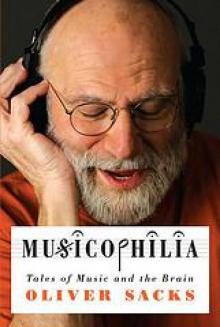 Musicophilia
Musicophilia The man who mistook his wife for a hat
The man who mistook his wife for a hat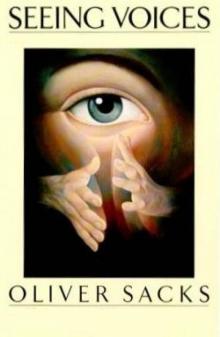 1989 - Seeing Voices
1989 - Seeing Voices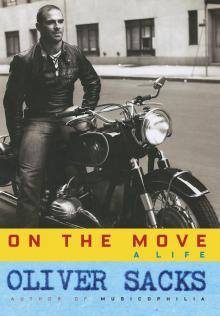 On the Move: A Life
On the Move: A Life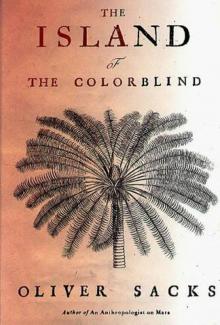 1996 - The Island of the Colorblind
1996 - The Island of the Colorblind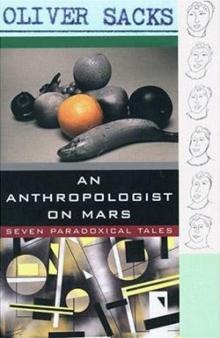 An Anthropologist on Mars: Seven Paradoxical Tales
An Anthropologist on Mars: Seven Paradoxical Tales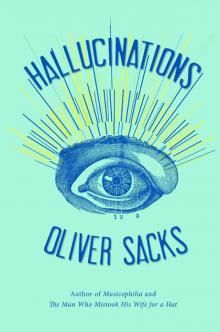 Hallucinations
Hallucinations Seeing Voices
Seeing Voices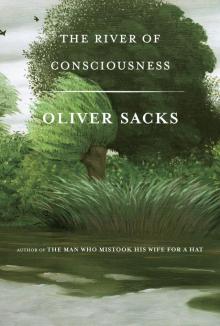 The River of Consciousness
The River of Consciousness Vintage Sacks
Vintage Sacks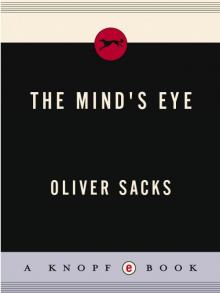 The Mind's Eye
The Mind's Eye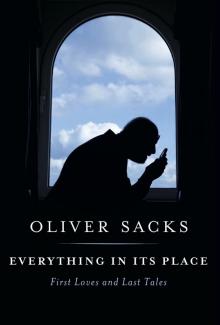 Everything in Its Place
Everything in Its Place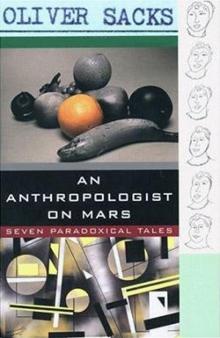 An Anthropologist on Mars (1995)
An Anthropologist on Mars (1995) Uncle Tungsten: Memories of a Chemical Boyhood (2001)
Uncle Tungsten: Memories of a Chemical Boyhood (2001)